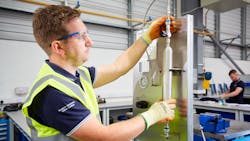When grab sampling is integral to the regular operations of a processing facility, an often-overlooked component of routine maintenance is keeping the sample cylinders in proper working order. Overlooking this vital step, however, is a mistake. If cylinders are damaged or malfunctioning, they can potentially put staff at risk. Furthermore, underperforming cylinders can cause problems with the accuracy and integrity of the sampling itself. Regular, proactive maintenance of sample cylinders is crucial for any processing facility that performs frequent grab sampling.
Questions of whether a small dent in the cylinder matters or what a damaged quick connect looks like come up frequently during cylinder maintenance discussions. To determine when cylinder maintenance is necessary, it is important to understand the elements that make up an effective program. Examining those elements closely will guide the facility team as they strive to keep their sample cylinders in working order.
Why a sample cylinder maintenance program is essential
In most process facilities, sample cylinders are particularly prone to wear and tear. They are used often and are usually transported from the sample point to the laboratory, where unintentional damage may occur in transit. In addition, sample cylinders are frequently handled by a variety of personnel, including technicians, operations team members and laboratory staff.
In those interactions, it is possible the cylinders might be connected and disconnected from sample points multiple times per day. Furthermore, they are often stored in truck beds, where incidental damage may happen. In short, damage to the cylinders could build up over time and result in potential safety risks.
Minimally, each cylinder should be inspected and pressure-tested annually. If local governments require certification, that should also happen according to the schedule required by the local jurisdiction. Even if cylinder maintenance is not required, it is an investment that should be made because if the cylinder fails, it could put team members and the facility at risk.
Determining whether a cylinder needs service
Though regular sample cylinder maintenance is critical, it may also be necessary to service cylinders outside of their regularly scheduled times. The question is how to tell if a cylinder needs to be serviced before an annual inspection or recertification.
As a start, it is important to inspect your cylinders’ valves and quick connects frequently because they are the two most commonly damaged components. Whether the damage occurs through repeated use, poor storage practices or improper connection and disconnection from the sampling point, it is important to identify the damage quickly so it can be repaired without incident. For example, damage to quick connects often happens at the stem, so a quick visual inspection can reveal if a stem is bent, which would mean the quick connect is not functioning properly.
Fortunately, damage to sample cylinder components does not necessarily require replacing the entire cylinder. In fact, by replacing components instead, facilities can ensure proper functionality and general safety at a significantly lower cost. For example, replacing a quick connect component will cost approximately 10% of what it would cost to purchase a completely new cylinder.
When cylinders should be replaced
No matter how robust a cylinder maintenance program is, all cylinders will eventually need to be replaced. Typically, this occurs when there is obvious, visual damage to the cylinder’s body, including dents, deep scratches or gouges. Additionally, if a cylinder has become misshapen through overpressurization, it should be replaced. Finally, signs of corrosion on the cylinder’s exterior may indicate its internal coating has degraded.
When these signs are obvious, the cylinder has sustained enough damage to be dangerous. Visibly damaged cylinders should be removed from service immediately to be repaired. If the damage is unfixable, cylinders should be replaced as soon as possible.
Taking a cylinder out of service, particularly on short notice, is not always easy, particularly if the plant has not planned ahead. If replacement cylinders or components are not easily available, significant downtime can occur as those parts are ordered. This disruption to the plant and its overall efficiency can be costly. Therefore, the most proactive plants have spare cylinders to avoid such an eventuality (Figure 5), although an effective ongoing maintenance plan will go a long way to making these events rare.
Creating an effective sample cylinder maintenance program
At a minimum, a proactive maintenance plan means sample cylinders should be inspected at regular intervals. A regular schedule allows plant operators to anticipate when groups of cylinders will be removed from service so replacements will already be on-site. Regular inspections also alert operations teams to potential problems before they become bigger, whether they are operational- or safety-related.
Working with a well-established cylinder supplier will allow for regular consultations to make sure sample cylinders are kept in peak working order. In fact, some suppliers provide regular inspections as part of their services, so the plant does not have to use its own team. Such activities should include visual inspections of the cylinders, assemblies and other components, including threads, needle valves, rupture disc valves and fittings. These inspections allow the supplier to alert a facility if a damaged cylinder may still be operable. The supplier should offer to create a detailed report, including images, and recommend which cylinders should be repaired or replaced. With this mission-critical function outsourced, in-house teams can focus their attention on making operations run more smoothly — while still keeping workers safe and secure.
To ensure a plant is functioning properly, it is essential to ensure sample cylinders are performing as they should. Seek out suppliers who can offer additional training on what to look for when inspecting cylinders and advise on how to create a well-executed, proactive maintenance program. In the end, sample cylinders are important components of an effective industrial operation, so paying attention to their maintenance should always be top of mind.
Tristian McCallion is custom solutions manager for Swagelok Edmonton.
An original version of this article appeared on the Swagelok Reference Point blog.


